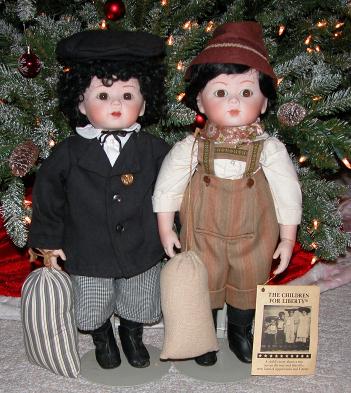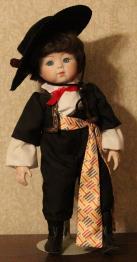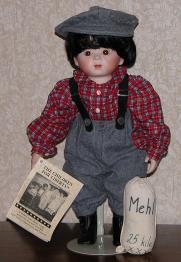
|
“Baby of Liberty” Dolls
In the mid 1980’s, The Statue of Liberty-Ellis Island Foundation, Inc. was formed to generate funds for the rebuilding and restoration of the Statue of Liberty and Ellis Island. The “Baby of Liberty Doll” was created to commemorate many things; one was to honor the 100th birthday of the Statue of Liberty as well as to help generate the funds and public awareness for restoration, also the doll was a symbol of the thousands of immigrants who came to America’s shores.
The idea of the doll originated with Doris Huber. Doris was born and raised in Brooklyn, New York across the Buttermilk Channel from the Statue of Liberty and Ellis Island. Doris vividly remembers her father taking her to the docks as a child to see the boats arriving with immigrants in search of a better life. She recalls parents lifting their babies and small children high above their heads so they could see the Statue of Liberty and recalls their shouts of, “America! America.” Thousands of immigrants were welcomed by the Statue of Liberty which celebrated her 100th birthday on October 28, 1986. Many immigrants spent long weeks on boats to overcome hardship, oppression, poverty and loss of freedom in their native lands. Many babies and children were taken aboard these boats and some were even born during the grueling voyage. Some of them did not survive . . .
Doris married and spent her adult life in Lancaster, New York. She was an art teacher in the Lancaster, New York school system for many years. Upon hearing of the project to restore the Statue and Ellis Island, she was inspired with the idea of having a doll made to commemorate those who came to the new world, and she thought that a baby doll would be a nice symbol. The doll would represent the new found freedom of those who walked through the doors of Ellis Island, and a portion of the sales could even help with the restorations. Inspired Doris then started to actively search for a company who could and would produce such a doll. She found someone willing to listen to her proposal at a small local porcelain doll shop called “Appletown Creations” owned and operated by Laura and Dale Hacker.
Trying to secure an official endorsement from the Statue of Liberty-Ellis Island was extremely challenging. But it finally came together and Appletown Creations was granted an official license from the Statue of Liberty-Ellis Island Foundation, Inc. A legal agreement was made between both parties that a portion of the selling price of every Baby of Liberty TM would be made to the foundation. A limited edition of 2,500 pieces were planned. But even though that number wasn’t sold the Foundation still required the endorsement fee for that quantity. Each Baby of Liberty doll is hand signed on its cloth body chest by Doris Huber and the limited edition number is written on the chest, as well as the back of the official brochure and tag on the wrist, that came with each doll. The outfits on the Baby of Liberty dolls were designed to look similar to those worn by babies of that time period. Hats were made with seven points to emulate the Statue of Liberty as well as the seven seas upon which many of our ancestors crossed to reach this land of freedom. Girls had lace on their hats and boys had little ear-flaps. Both sexes came with long dresses that had little tucks along the hemline to look like dresses worn by babies in the late 1800’s to early 1900’s era. All dolls wear a gauze-like diaper and a belly band. The dolls wore long stockings and high buttoned short boots. Some of the girls even have pierced ears, tied with string (as was the custom, see close-up picture shown above). Many children had tags placed on their wrists when they came to Ellis Island for identification purposes, as children were taken from their parents and placed in a nursery or play area until their parents/guardians could have their paperwork inspected and get their medical examinations. Children were also given flags of their new homeland as a memento . . . The Baby of Liberty also has a little flag too. The most unique feature about this doll is that they were all custom made to ORDER. Buyers could choose the sex, hair and eye color, and if a girl they could get either pierced or non-pierced ears. In some cases the option of straight or curly hair could also be selected as well as a specific skin tone. Colorful ribbons were pinned to the chests of these dolls to represent their country of origin (colors were based on colors of the homeland flag- for example a Polish baby would have a red and white ribbon, German would have red and gold, etc). The baby doll could also be named after an ancestor if the buyer wished and we would put that name on their wrist tag. All dolls were hand made and cast of the finest Seeleys porcelain, greenware was cleaned and then fired to over 2200 degrees. The dolls had porcelain head, hands and feet with a cloth body. Eyes were hand-painted to a customer’s specification. After being china painted and sent thru another firing, the baby was assembled to a customer’s order. Clothing for these dolls were sewn by various local seamstresses in Western New York. Many people contributed to the production of these dolls. This doll stands around 16” high. These limited edition dolls were originally sold for $129.95 USD (plus tax).
“Littlest Immigrant Baby”
The “Littlest Immigrant Baby”, was a smaller version of the Baby of Liberty doll. It represented the immigrant newborn. These dolls were produced but were not licensed by the foundation. This newborn came with a receiving blanket, a simple white gown which had a small camphor bag attached to the upper right chest, silky white stockings a gauze-like diaper & belly band. The Special Signed Limited edition, baby also came with either a blue or pink scroll and tag (blue for boys and pink for girls). These dolls were hand numbered on their chest and signed by Doris Huber. Like the Baby of Liberty these dolls could also be ordered with a specific eye and hair color. Dolls have cloth body with porcelain head and hands. Eyes were hand painted and doll measures around 12.5” long. These special edition dolls were available for the special price of $49.95 USD (plus tax). |
|
“The Children of Liberty”
The “The Children of Liberty”, were the dolls which represented the older children who came to America. These dolls were produced but were not licensed by the foundation. The dolls were hand numbered on their chest and signed by Doris Huber. Like the Baby of Liberty these dolls could also be ordered with a specific eye and hair color as well as country of origin. The children dolls have porcelain head, hands and feet with life-like acrylic eyes. These dolls were more unique in the types of clothing and outfits made for them. The hair styles were also much more varied. A lot of research was done looking at pictures of children from that time period in an attempt to make clothing which would best represent children from a specific ethnic group. Many of these dolls all wore the standard black or brown knit stockings and ankle high boots. They had undergarments. Boys often wore knee high pants or knickers and a simple shirt. Girls were given a blouse and skirt and sometimes a vest. Great attention was given to details on these dolls and the little extras- such as the gold medallion sewn to the lapel of the Italian boy’s coat. Many Italians were very religious and it was common to wear religious relics for protection and a safe passage to an unknown land, so we included this on the dolls too. The German boy had a Bavarian type pants with embroidered straps. The boy dolls were given sacks (or drawstring bags) to carry their belongings and worldly possessions to the new world. The Italian boy’s striped bag was supposed to represent a pillow case cover that he carried his belongings in. The girls were given a small cloth doll or a wicker basket with flowers to carry. When the children arrived with their parents/guardians at Ellis Island families were often assigned a number, to help authorities keep the family units together. We put numbers on the dolls too (this number was not the same as the limited edition number written on their bodies), these numbers were on a piece of white cardboard and usually represented a specific “ethnic” group. For example the # 4 was put on all the German boys (as shown in picture below), the German girls all receive the # 8 and so on. Any less common ethnic groups were given the # 1 tag. It should be noted that there were also some “store display” samples that were made for the purpose of showing various ethic groups we offered, these samples usually were assigned with the lower limited edition numbers on their bodies (see photos below of the rare Spanish boy and the India girl and boy). Store display models were also made available for re-sale, dolls stand around 20” high. These special edition dolls were available for the special price of $185.95 USD (plus tax). |

|
Shown at left is an Italian and German boy. Outfits shown above (l-r) are– Italian boy, German boy and Polish boy. Boys were given a one-piece undergarment. All dolls were signed on the chest of their body with their special edition number. Generic tags with four different stories were available to choose from (see sample of one tag story shown below). |


|
Shown at the right are two very rare “Children of Liberty” dolls- A girl and boy from India, that were originally made as store display models. Notice the “googly” eyes in both as they appear to look at each other. The boy has an outfit made of natural muslin and a white cotton turban. Girl wears a light peach colored silky top and matching skirt with a black and gold lace sari. Both carry wicker baskets. These rare Children of Liberty dolls limited edition numbers are- #23 & #24. They both have chocolate colored cloth bodies which match their porcelain skin-tone.
[pictures posted with permission by current owner] |
|
We made many different ethnic groups in the “Children of Liberty” series but I may not have photos of all of them. If you are the owner of a “Child of Liberty” doll that is not shown here on this webpage, please do contact me and I will be happy to post a picture of your doll on this webpage for others to see. |

|
Another innovative idea that came out of Appletown Creations were the “Bear-ly Kids” these stuffed toys had bear faces on one side and the opposite side they had a porcelain doll face with life-like acrylic eyes and a wisp of hair. The idea was to generate that the “heart of a kid” resided inside each teddy bear. * AT-1: was the smallest bear and had a repro-Googly face. The small Bearly-Kid stood around 14” high, and originally sold for $39.94 (plus tax). * AT-4: was the medium bear and had a repro–German face with an open mouth. The medium Bearly– Kid stood around 17” high, and sold for $49.95 (plus tax). * AT-3: was the largest bear and had a repro-French pouty face. The large Bearly-Kid stood around 21” high, and sold for $89.95 (plus tax). * AT-2: was probably the most unique of all, this was the little boy with a smiley face and painted hair in sheepskin clothing. Once his lambskin hood was removed (the ears slipped thru the slots in the hood), the head could be rotated to reveal a black-faced sheep, he stood around 16” high, and sold for $49.95 (plus tax).
All of these Bearly-Kids were fully jointed and came in several different fur varieties. Each had a leather tag located in between the left leg joint and the body identifying them with the Appletown logo and the year made (see photo below). Bears all had genuine leather paws, some bears had black glass eyes but for safety concerns later models had the plastic lock-tight eyes. All were hand made and assembled in Lancaster, New York. Optional custom made padded bonnets (to protect the porcelain faces) were also available as well as a pair of matching panties at an additional charge if desired. All bears came with a bow around their neck and a little tag. |


|
Pictures above show examples of box & brochure as well as some of the Baby’s that were made (the back of the heads were hand written in black china paint on some of the first dolls, later dolls had the info etched in the back of their heads). Different flesh tones were available (white, brown and indian). Girls came in either pierced or non-pierced ears (string was put in their ears). Limited edition numbers written on front of baby’s chest near Doris Huber’s signature, as well as on back of brochure and wrist tag. Ribbon colors pinned to baby matched flag colors of baby’s native homeland. |
|
Research for producing these dolls was done by looking over several old photographs to get a feel for the type of clothing worn by babies and children from the late 1800’s to early 1900’s. Shown below are photos from that period, gowns and padded clothing were worn on both boys and girls. |




|
Shown above are samples of other “Children of Liberty” dolls- (l-r); Polish Boy, German Boy & Girl. The rare Spanish boy shown was a store display model (he was the only Spanish boy created for this series). |



|
Appletown Creations |
|
Bear-ly Kids |
